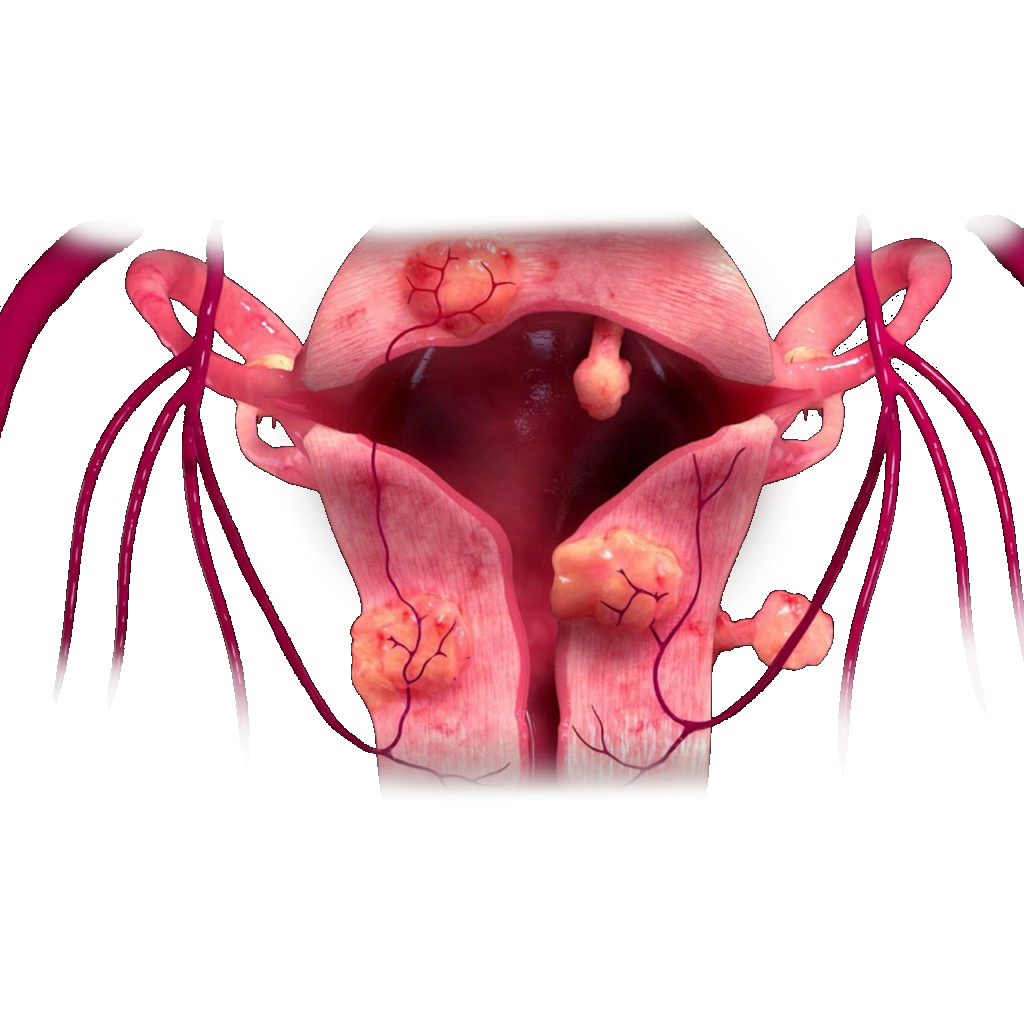UTERINE FIBROID EMBOLIZATION
What are Uterine Fibroids?
Uterine fibroids, also known as myomas or leiomyomas, are muscular tumors that sometimes form on a woman’s uterus. These tumors come in various sizes, shapes, and positions and may be so small that they cannot be seen by the naked eye or grow in large masses that affect the shape and size of your uterus.
These tumors generally attack women of childbearing age (typically 30 to 40), but they may potentially affect women of any age. For unknown reasons, they are notably more prevalent and aggressive in African-American women than in Caucasian women. Still, they are ultimately benign or non-cancerous 99 percent of the time, and getting them doesn’t necessarily mean you are at a higher risk of developing uterine cancer.

What are The Risk Factors for Uterine Fibroids?
Certain factors might place you at a statistically higher risk of developing uterine fibroids, including:
- A family history of fibrosis
- Childlessness
- A delayed menopause
- Getting your first period at an early age (early onset puberty)
- Obesity, or being more than 20 percent of your recommended weight
- Ethnicity (African Americans are statistically at a higher risk
- Alcohol consumption
- Use of birth control (ascribed to its interaction with your hormonal balance)
- Too much red meat in your diet at the expense of fruit, vegetable, and dairy
What are the symptoms related to this disease?
For most people, uterine fibroids will cause very little, if any, signs and symptoms. In such instances, these are referred to as asymptomatic fibroids. Relatively larger fibroids may cause various potential symptoms, including:
- Bleeding between your menstrual cycle days
- Painful or significantly heavier flows during your periods
- Uncommon pain while engaging in intercourse
- Abnormally frequent urination (this comes about when a large fibroid mass begins pressing on your bladder)
- Chronic (persistent) vaginal discharge
- A noticeable abdominal enlargement (distention) that makes you seem pregnant
- A complete inability or significant difficulty while trying to empty your bladder
- Constipation without any dietary changes
- Lower back pain
- Bloating or a feeling of fullness in your lower abdomen
As the hormone levels in a patient’s body begin to dip after they have been through menopause, the symptoms of uterine fibroids will typically begin to disappear or stabilize.
How are Uterine Fibroids Diagnosed?
Most people discover that they have uterine fibroids during their regular medical checkups. This usually occurs during the pelvic examination as part of any pre-natal or gynecologic examination. For people with symptomatic uterine fibroids, heavy periods and other related symptoms might prompt your healthcare provider to schedule further tests to determine potential fibroids’ presence, size, and location. These diagnostic test measures include:
- Magnetic Resonance Imaging (MRI): This test makes use of magnets and radio waves to create detailed images of a patient’s internal organs
- Ultrasonography: This non-invasive test uses sound waves to create a picture of a person’s internal organs. This ultrasound test might be carried out via a transabdominal or transvaginal route, depending on the size of the patient’s uterus.
- Hysteroscopy: Here, your physician will use a scope (a flexible, thin tube fitted with a camera on its end) to view the fibroids inside your uterus. The procedure involves moving the scope through the vagina and cervix into the uterus for an up-close look.
- Computed Tomography (CT): CT scans involve using X-Ray imaging technology to create detailed images of a patient’s internal organs from multiple organs.
- Laparoscopy: This procedure involves making a small incision on the patient’s lower abdomen and inserting a thin, flexible tube fitted with a camera to look at their internal organs.
The Management and Treatment of Uterine Fibroids
There are different approaches you and your healthcare provider may take to mitigate or comprehensively deal with uterine fibroids. Patients with mild symptoms might prefer to take medication that manages these symptoms, but those with moderate to severe symptoms might be better served by undergoing surgical intervention.
Uterine Fibroid Medications
These interventions are suited to patients that experience mild symptoms due to their condition. Some common or popular medications include:
- Iron Supplements: This is prescribed to people who experience heavy bleeding due to their condition and suffer from anemia.
- OTC (Over-The-Counter) Pain Medication: These pills can be used to help mitigate the discomfort and pain the patient suffers and may include ibuprofen, acetaminophen, and so on.
- Birth Control: Menstrual cramps and in-between bleeding periods are symptoms that may be alleviated by birth control, which may be administered in the form of oral contraceptive pills, IUDs (Intrauterine Devices), injections, and intravaginal contraception.
- Gonadotropin-Releasing Hormone Agonists: GnRH agonists are injections or nasal sprays that work by shrinking the patient’s fibroids. These are temporary interventions, however, meaning the fibroids may resume if the patient stops taking them.
Uterine Fibroid Surgeries
These are suited to patients experiencing moderate to severe symptoms. The most common surgical options include:
- Myomectomies: Should a patient suffer from moderate to severe symptoms yet wish to become pregnant in the future, then this might be their most viable treatment option. In myomectomies, surgeons will try to take out uterine fibroids while leaving healthy tissue intact so that the patient retains the ability to become pregnant afterward successfully. The procedure may be carried out laparoscopically or through abdominal surgery.
- Endometrial Ablation: Here, surgeons will use wire loops, lasers, boiling water, microwaves, or electric currents to destroy or remove the patient’s uterine lining entirely. This is a minor surgery that you can have as an outpatient, resulting in discontinued periods and the inability to fall pregnant.
- Hysterectomies: This surgery completely removes the patient’s uterus and can be done via laparoscopy or abdominal approach. It is a major surgery but will completely remove any fibroids.
- Uterine Fibroid Embolization (UFE): This procedure is known as Uterine Artery Embolization (UAE). The procedure involves having a doctor block the blood flow to the patient’s fibroids by inserting plastic particles or a gel into the blood vessels around the fibroid. Once the fibroids are denied the blood they need to survive and grow, they will eventually shrink back down.
Aside from the symptoms being experienced, the size of the fibroids, their location, and the patient’s age, a major factor to consider will be whether or not the patient hopes to become pregnant in the future, as some treatments will make this difficult, if not impossible in the future. As different cases of fibroids will differ from patient to patient, the choice of medication or treatment should be carefully considered and discussed in detail with your healthcare provider.

Our Uterine Fibroid Embolization services are designed with you in mind. With our help, you’ll be able to get back on your feet as quickly and efficiently as possible when you visit us. And if you have any questions or concerns at all during your treatment, our team of doctors, nurses, and other medical professionals will be there to answer them before they even become problems.



